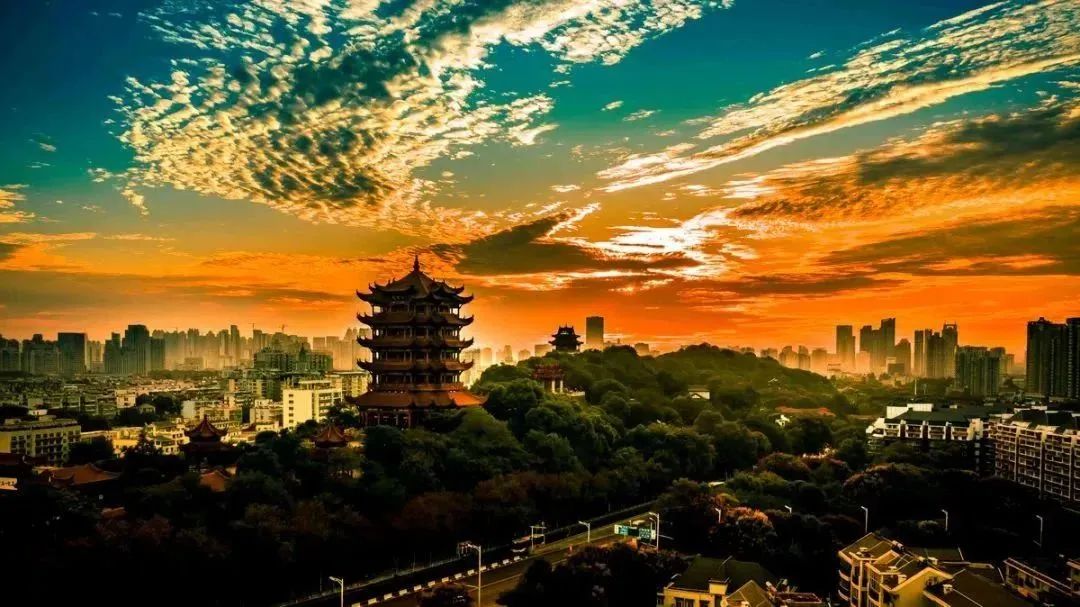The front wall of the second floor hall is adorned with marble carvings of the Tang Dynasty’s Yan Boli’s “Record of the Yellow Crane Tower”, which records the rise and fall of the Yellow Crane Tower and anecdotes of celebrities; On both sides of the Lou Ji are two murals, one of which is “Sun Quan Built the City”, vividly depicting the history of the successive birth of Huanghe Tower and Wuchang City; The other one is “Zhou Yu’s Banquet”, reflecting the activities of celebrities from the Three Kingdoms to visit the Yellow Crane Tower.
Regarding the naming of the Yellow Crane Tower, there are two theories: “due to mountains” and “due to immortality”.
01 Geographical location: Huanghe Tower, located in Wuchang District, Wuhan City, Hubei Province, at the top of Snake Mountain, bordering the Yangtze River for thousands of miles, is a landmark building in Wuhan City; Founded in the second year of the Wu Huangwu reign of the Three Kingdoms period (223 AD), it has been repeatedly renovated throughout history.
It is said that there was a fairy driving a crane here, hence the name
.
There are two theories: “due to immortality” and “due to immortality”.
It is also known as the “Three Famous Buildings in Jiangnan” along with Yueyang Tower in Yueyang, Hunan and Tengwang Pavilion in Nanchang, Jiangxi.


There are long scrolls and murals displayed in the top hall of the fifth floor, such as the “Yangtze River Miles Map”.

On the first floor, there is a tall and spacious hall, with a central caisson reaching over 10 meters high.

Since ancient times, it has been known as the “Wonderful Scenery of the World” and is known as the “Three Famous Scenic Spots in Wuhan” along with Qingchuan Pavilion and Guqin Terrace.
The existing building is based on the prototype design of the Qing Dynasty’s “Tongzhi Tower” and was rebuilt in 1985; Due to the poem “Yellow Crane Tower” written by Tang Dynasty poet Cui Hao when he climbed the tower, he became famous all over the world.
02 Architectural Features The main building of the Yellow Crane Tower is a four sided octagonal shape, reinforced concrete frame wood like structure.
They also extract famous lines from their chants of the Yellow Crane Tower.

It is the first of the “Ten Scenic Spots in Wuhan”, one of the “Four Famous Buildings in Ancient China”, and one of the “Ten Famous Historical and Cultural Buildings in China”, and is known as the “First Building in the World’s Rivers and Mountains”.
It is supported by 72 columns, and there are 60 tilt angles extending outward on the floor; The building is surrounded by cast bronze yellow crane, Shengxiang pagoda, memorial archway, porch, pavilion and other buildings, with a unique national style.
From the first floor, the overall building mainly shrinks upward, enhancing the firm stability of the building; The overall height of the building is 51.4 meters, the bottom floor is 30 meters wide, the top floor is 18 meters wide, and the eaves are five stories wide.
On the front wall, there is a huge ceramic mural of “White Clouds and Yellow Cranes”, and on both sides of the pillars, couplets hanging up to 7 meters long: the refreshing air comes from the west, and clouds and mist sweep away the earth and shake; The great river flows eastward, and the waves wash away ancient and modern worries.
The roof of pyramidal roof Building is covered with golden glazed tiles.
The lobby on the fourth floor is divided into several small halls with screens, containing contemporary celebrity calligraphy and paintings for tourists to appreciate and purchase.
The murals in the third floor hall are “embroidered portraits” of Tang and Song celebrities, such as Cui Hao, Li Bai, Bai Juyi, and others.



